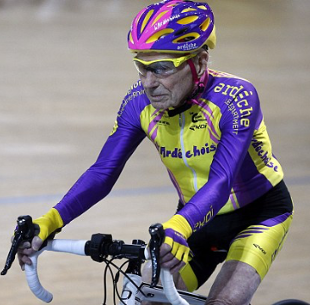This is the fourth part of an 8-part series.
Introduction
In the last two decades of my life I’ve developed a lot of respect for senior and super-senior athletes. There are some highly motivated and talented older people who are quite active and successful in their own unique ways. Over the next few posts I’ll highlight the achievements of a few I’m aware of. Let’s start with a truly amazing one…
The picture below is of a French centenarian cyclist, Robert Marchand. In 2014 he set a one-hour track record of 26.927km (16.732m) for his 100-104 age group improving on his previous 2012 record of 24.250km (15.068m). To accomplish that he is reported to have increased his VO2max by 15%.
Then at 105 he set a record for his new age group of 22.547km (14.010m). There are a lot of 25-year olds who couldn’t ride that far in an hour. After his last one-hour track record he was still riding an hour a day on an indoor trainer. At age 106 he finished a race of 4,000m on the track and later agreed with his doctor to stop racing. But he kept on riding until age 108 when he gave it up after losing his hearing. He died in 2021 at age 109. He was quite an impressive person in so many ways.

Part 4: Little Things That Get Worse with Age
If you are like me, as you age up in the senior ranks you become acutely aware of things that are changing. These are mostly physical adjustments your body is making (I’ll touch on the psychological changes with advancing age in a later post).
Some are significant—almost scary—while others are quite small and seemingly inconsequential. In Part 3 I touched on the changes in my muscle flexibility and joint mobility in my late 60s. These weren’t huge things, but ones I was certainly aware were happening. I don’t know why, perhaps because of my consistent dedication to hip and lower spine flexibility and mobility, but the problem seems to have plateaued or perhaps even gotten slightly better in the last few years.
In that previous post I was only skimming the surface of small physical changes. There are a lot more. This could go on for a few weeks, but in the interest of time (and my psyche) I’ll touch on only a few more in this post. After a while it becomes a bit burdensome for both you and me if all I talk about is problems. I promise this will be the last post on this topic.
Let’s get started…
Looking down and posture
Here’s a little matter that I see lots of older people needing to deal with but not always doing so. I noticed in my late 60s that I was looking down at my feet while walking and that my posture when sitting had become rather sloppy. I see lots of other seniors doing the same things.
This doesn’t seem like a big problem, but over time I was afraid it could become one. Looking at your feet while walking places a great deal of stress on the bones and soft tissues of the lower back. I learned that the hard way, I’m afraid, as I’ll explain shortly.
Now I remind myself to walk with chin up and head balanced directly over my shoulders. I also have to prompt myself frequently to sit with good posture. No slouching. Again, the spine and back muscles are affected. My wife is good at reminding me of these. As I said in an earlier post on this topic, the older you are, the more important everything becomes—diet, resistance training, aerobic exercise—and your posture.
Weight gain
Perhaps the biggest challenge facing senior athletes is weight gain. I can tell you all about it. From 17 to 71 years of age I weighed about 154 pounds (70kg). From ages 71 to 76 I gained 20 pounds (9kg). Nothing changed in my lifestyle—not my diet, my training, or anything else. Only my age. I slowly morphed into someone I didn’t fully recognize.
When I was younger I could eat as much as I wanted, and I still stayed skinny. Now at 79 I’m always aware of what I eat and my weight. It slowly rises and I slowly bring it back down again. It comes down when I eat only to satisfaction and then stop. No snacking. Dessert is a piece of fruit. It goes up when I break these guidelines. Older people told me about this when I was young. But I never thought it would happen to me.
Doctor visits
This one really bugs me—trips to see a doctor. I recall reading an article about a 90-something who said there are two primary things in her life: spending time with doctors and conversations with friends comparing visits to doctors. I believe it.
I’m still a good way from being 90 years old, but it seems I spend a lot of time with doctors anymore. In 2022 I made about two dozen such trips. I had two surgeries (a kidney stone removal and a spinal fusion), which each required a few pre-surgery and follow-up sessions, several “medical procedures,” a whole bunch of visits for little things that concerned me, and a few of general checkups involving blood samples, x-rays, and MRIs.
Looking back, several of these visits were for naught, but my general practitioner, like most, is very conservative when it comes to a patient’s health. Better safe than sorry. I agree. That means I see a lot of doctors. I’m hoping for fewer such visits this year. We’ll see.
My next post on the topic of senior athletes, Part 5, will address the upsides of being a senior athlete.

You must be logged in to post a comment.